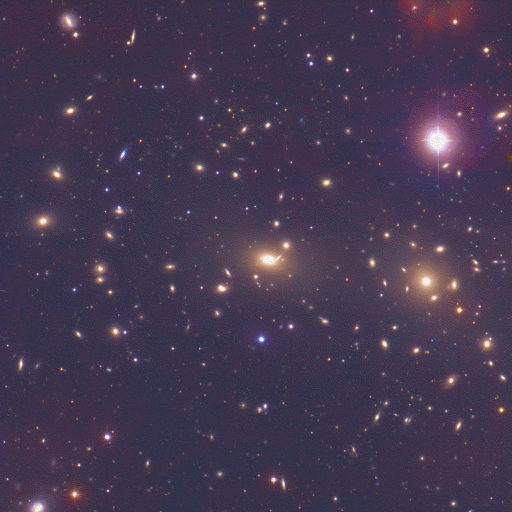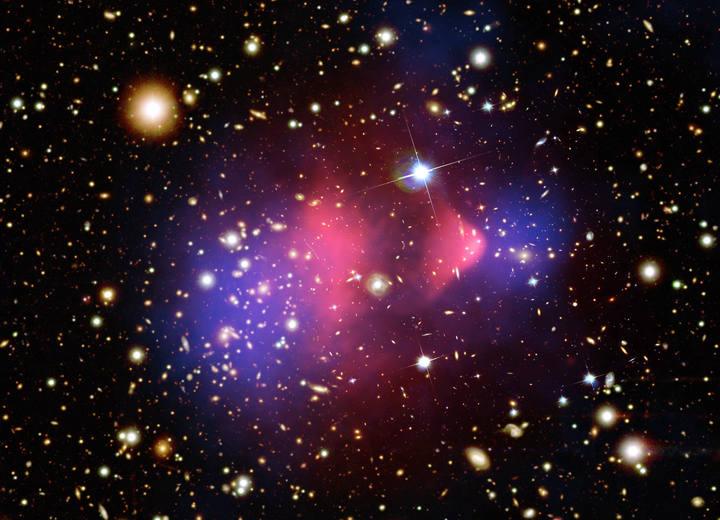Evidence for Dark Matter
| In the 1930s the Swiss astronomer Fritz Zwicky observed a group of galaxies close to each other (a galaxy cluster). From the amount of light he saw, he determined how much mass there should be. Since the motion of astronomical objects is determined by gravitation, he was able to calculate the velocities the galaxies should have in average. He also measured the velocity directly and found a large discrepancy: to explain the measured velocities more than two orders of magnitude more mass was needed than what was accounted for by the visible matter. Zwicky concluded that there must be some additional invisible or dark matter. (Zwicky, F. 1933, Helv. Phys. Acta 6, 110) |  |
 |  |
Coma Cluster of Galaxies. Zwicky found that the mass of the cluster determined
from the motion of the galaxies is much larger than the mass that can be attributed
to visible objects. (Picture Credit: O. Lopez-Cruz and I. K. Shelton (U. Toronto), Kitt Peak National Obs.) |
Zwicky was not the first one to observe irregularities. A year earlier the Dutch astronomer Jan Hendrik Oort had observed that the stars in our galactic neighbourhood are moving too fast as well. He also used the term dark matter but considered that this could be explained by ordinary stars which are either dim (or dark) or - especially for matter close to the centre of the Milky Way - hidden from us behind other stars. ( J.H. Oort, 1932, Bull. Astr. Inst. Netherlands, 6, 249
Zwicky's observation is based on the fact that a certain amount of mass is needed to produce the measured amount of light (the mass-to-light ratio). Even though this was believed to be known fairly precisely, there could be subtleties that would change this ratio and therefore the conclusion. This is not true for one of the most compelling pieces of evidence for the existence of dark matter, the rotation curves of spiral galaxies.
To explain the observation we need to assume a more or less spherical distribution of dark matter, a so called halo which surrounds the galactic disk and extends much farther out in space than the visible part. (Rubin,V.C., Ford, W.K. & Thonnard, N. 1978, Astrophys. J. 225, L107)
Since then a large number of observations on the scale of galaxies, galaxy clusters and the universe as a whole have been made, which tell us that only about 15 % of the matter in the universe is normal matter as we know it (that is: matter made out of atoms), and of these 15 % only a small fraction is emitting light.
|
One of these observations, the so called bullet cluster, has become quite famous. In this system of two galaxy clusters we observe the consequence of a cosmological crash, which has separated the dominant component of normal matter from the dark matter. The composite picture on the right shows as an overlay to the optical image of the region of the sky in red the distribution of normal matter and in blue the distribution of the gravitational potential, which must come from dark matter, since it is at a different position than most of the normal matter. By far most of the mass of an atom is concentrated in the nucleus. The components of the nucleus belong to a class of elementary particles called baryons. Therefore we call the normal matter that does not emit light baryonic dark matter. The remaining 85 % of matter which is not made of atoms is called non-baryonic dark matter. The non-baryonic dark matter is what we are searching for with SuperCDMS. |  |
 (Picture Credit: X-ray(pink): NASA/CXC/CfA/M.Markevitch et al.; Optical: NASA/STScI; Magellan/U.Arizona/D.Clowe et al.; Lensing Map (blue): NASA/STScI; ESO WFI; Magellan/U.Arizona/D.Clowe et al.) |
Alternative Explanations?
All the evidence described above is based on gravitational effects. So one might ask the question: could it not be that the problem is not missing matter, but our miss-understanding of gravity? Or a miss-understanding of how gravity acts on astronomical objects?
Several attempts have been made of such alternative explanations, most notably the Modified Newtonian Dynamics (MOND). All these explanations have in common that they can account for some of the long list of observations, but by far not all. MOND e.g. has been designed to explain the rotation curves of spiral galaxies, but it cannot account for most of the other observations that point towards the existence of dark matter. While this is not a prove that these theories are wrong, it makes them much less appealing than the assumption of dark matter, which can relatively easily be made compatible with our general picture of fundamental physics and can explain the whole suite of observations.

